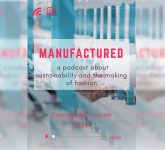Apparel retailers have sold merchandise at a much slower rate throughout the COVID-19 crisis, but they’re far from the only parties in the supply chain that have been impacted.
Further up the supply chain, raw materials manufacturers are hurting, too, and the tensions that have arisen over canceled orders and paused production have exposed the need for a new and improved buyer-supplier relationship. The solution, in part, is simple, according to Bombyx vice president Hilmond Hui: communication.
“I would much rather someone tell me that they can’t place purchase orders and they can’t give me the quantities that
they use to give me, as opposed to promising ‘Yeah, we’re going to give you 10,000 pieces,’ and then cancel the order,”
Hui told Sourcing Journal in its latest “On the Ground” video .
At Bombyx , partnership seems to be working as intended, which is part of what has kept the China-based silk textiles
producer on the right track amid the challenges.
That’s thanks to “great partners that have been very transparent with us regarding their financial and their market situations,” Hui said. “Our customers came to us and told us what they needed, and we sort of worked together to see if we could come up with a creative solution.”
That transparency has enabled Bombyx to make better, faster decisions and simultaneously ease the retailers’ financial
stress, whether through splitting up shipments into sea and air or slowing the production end of the supply chain.
Although the company’s silk supply has been largely unaffected by the pandemic, Bombyx intentionally decreased its
silk-farm output as demand declined, instead opting to focus on other crops.
“Our farmers now have a chance to maintain an income via the other crops that we work with in intercropping and rotational cropping,” Hui said. “That’s part of what we do with regenerative agriculture, and the beauty of this particular aspect of that is that the intercropping and rotational cropping allows for many different crops to thrive on the same land.”
Other silk farms that have gone another route aren’t faring as well, and the sector could face challenges ahead as silk prices continue to slide.
Going forward, as more retailers and suppliers work to navigate the post-pandemic supply chain and plan for its availability of raw materials, Hui said verticality will be increasingly critical to improving flexibility, both financially and operationally.
“Our output is ready to be at full capacity as if COVID never happened,” he said. “As soon as demand increases, our capacity is there, and we are ready to fire.”



